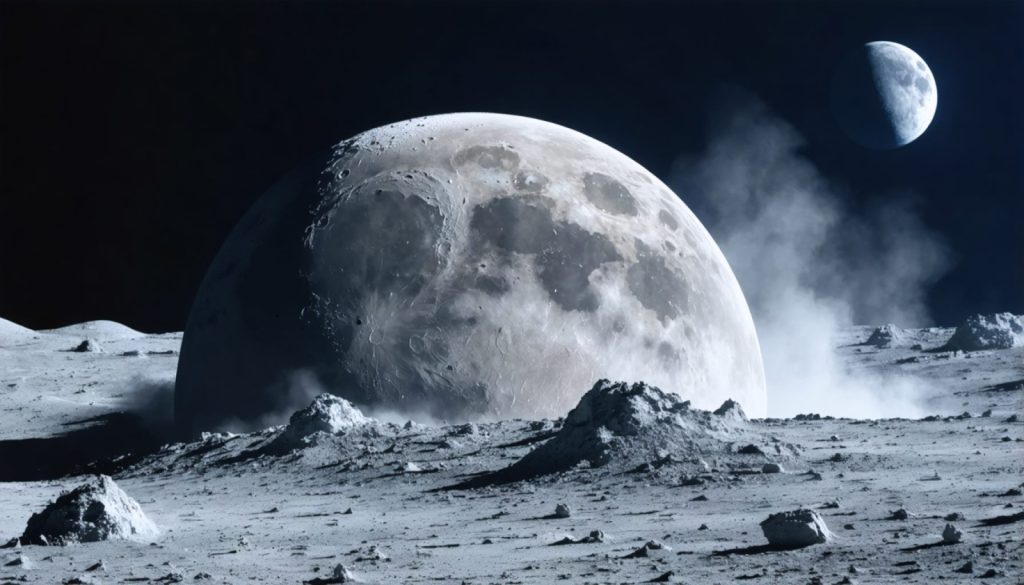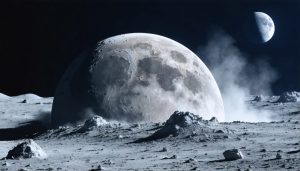- Lunar regolith contains ilmenite, a mineral rich in oxygen, essential for rocket fuel.
- Unlike water, regolith is abundantly available on the moon, making it a viable resource for oxygen extraction.
- Laboratory techniques exist for extracting oxygen from ilmenite, but challenges remain in applying these methods on the lunar surface.
- The proposed extraction system involves heating regolith to release oxygen, yielding water, iron, and titanium as byproducts.
- NASA may soon test hardware prototypes designed for lunar oxygen extraction, advancing space exploration sustainability.
- This innovative process could significantly support life and exploration missions, marking a new chapter in humanity’s lunar ambitions.
- The moon’s silent landscape holds vast potential, offering resources to fuel the journey beyond Earth.
Lunar landscapes, often portrayed as barren and still, hold untapped potential far beyond their stark beauty. Amid the silence of the moon lies an unexpected treasure: regolith, the ubiquitous dust blanketing the surface. A byproduct of relentless meteorite impacts, regolith may hold the key to humanity’s next leap in space exploration.
Within this fine, gray material lurks an exciting possibility—oxygen, the heavyweight of rocket fuel components. Unlike water, whose lunar abundance remains a mystery, regolith is undeniably plentiful. The dusty blanket is packed with a cocktail of minerals, including ilmenite, a compound prized for its oxygen-rich nature.
Visionaries have puzzled over the chemistry of extracting oxygen from regolith, yet translating laboratory feats into lunar practicality poses a formidable challenge. A team of researchers hones in on ilmenite, a mineral with a storied past. The method of divining oxygen from it is already decades old, with practical endeavors stretching back to the 1970s. Past efforts have produced hardware prototypes, one of which might soon land upon the lunar plains as part of a NASA mission.
The proposed system is an alchemist’s dream: Regolith, harvested from the dusty swathes of the moon, would undergo purification. Mingling with hydrogen at searing temperatures, ilmenite would release its oxygen, leaving behind pure iron and titanium. The byproduct—water—would split, recycling hydrogen and liberating precious oxygen, ready to propel rockets skyward.
This transformative process, brewing beneath the moon’s ancient dust, opens new frontiers for sustaining life and fueling the voyage beyond. In lunar dust, humanity finds a partner in ambition, ready to elevate dreams to reality. The moon’s quiet surface, it seems, echoes with potential—a call to adventure amidst the silence of space.
Unlocking the Moon’s Hidden Goldmine: The Untapped Potential of Lunar Regolith
How-To Steps & Life Hacks: Extracting Oxygen from Lunar Regolith
1. Collection of Regolith: Start by gathering lunar regolith using lunar rovers equipped with specialized collection instruments. This step involves collecting large quantities of the dust for processing.
2. Purification Process: The collected regolith needs to be purified to increase the concentration of useful minerals like ilmenite, which is vital for oxygen extraction.
3. High-Temperature Reaction: Heat the purified regolith in the presence of hydrogen gas at temperatures above 900°C. This causes a chemical reaction where ilmenite releases oxygen.
4. Water Production & Electrolysis: The reaction yields water as a byproduct, which can be electrolyzed to separate hydrogen and oxygen, with hydrogen recycled back into the process.
5. Storage and Usage: The extracted oxygen can be stored in tanks for use as rocket propellant or life-support purposes.
Real-World Use Cases
– Space Exploration: The ability to produce oxygen on the moon can significantly reduce the cost of space missions by eliminating the need to transport large quantities of oxygen from Earth.
– Sustainable Lunar Bases: Creating breathable air and rocket fuel on the moon could sustain lunar habitats and long-term missions, facilitating continual human presence.
Market Forecasts & Industry Trends
– Industry Growth: The space resource utilization industry is projected to grow significantly, particularly with entities like NASA and private companies like SpaceX and Blue Origin focusing on sustainable lunar exploration.
– Investment Trends: Increased investments in space technologies can be expected as companies aim to capitalize on lunar resources.
Reviews & Comparisons
– Comparison with Other Methods: Compared to water-ice mining, regolith processing for oxygen extraction is advantageous due to the widespread availability of regolith across the lunar surface.
Controversies & Limitations
– Technical Challenges: The regolith-to-oxygen process requires precise conditions and robust technology, which may pose logistical challenges on the lunar surface.
– Long-Term Environmental Impact: The potential environmental implications of large-scale regolith harvesting on lunar geology need to be carefully considered.
Features, Specs & Pricing
– Prototypes and Development: NASA has developed various prototypes for regolith processing; however, actual deployment and operational costs remain speculative at this stage.
Security & Sustainability
– Self-Sufficiency: Leveraging lunar regolith could lead to greater self-sufficiency for lunar settlements, reducing dependency on Earth-based supplies.
Insights & Predictions
– Future Prospects: The successful extraction of oxygen from lunar regolith might catalyze a new era of space exploration, with potential for multi-planetary human habitats.
Pros & Cons Overview
Pros:
– Reduces dependency on Earth for oxygen.
– Provides a local source of rocket fuel and life support.
– Promotes the sustainability of lunar missions.
Cons:
– Significant initial investment in research and technology.
– Potential geological and ethical concerns need addressing.
Actionable Recommendations
– Focus on Technology Development: Invest in the research and development of technology that can efficiently handle the unique challenges of lunar oxygen extraction.
– Collaborate with Space Agencies: Partner with established space agencies to share resources and knowledge towards common goals of lunar exploration.
Quick Tips
– Stay informed about developments in lunar exploration through reputable space news outlets.
– For companies, explore collaborations with aerospace firms and research institutions involved in lunar missions.
For further insights and opportunities in space exploration technologies, visit Nasa.










More Stories
The Dark Side of Fame: The Price South Korean Celebrities Pay
From the Gridiron to Hollywood: Marshawn Lynch Tackles New Role in “Euphoria”
Mini Crossword Mayhem: Your Daily Brain Teaser Fix